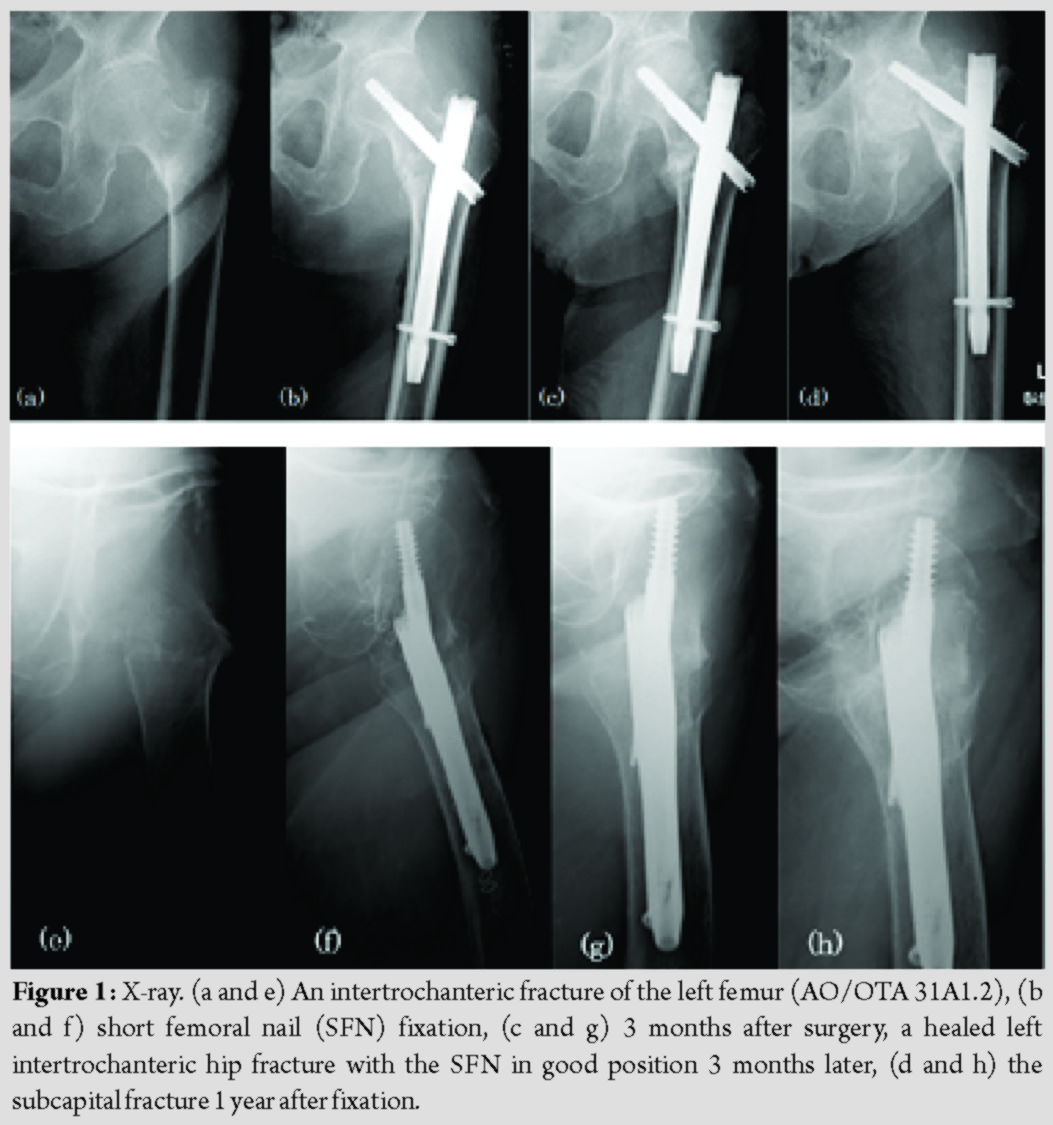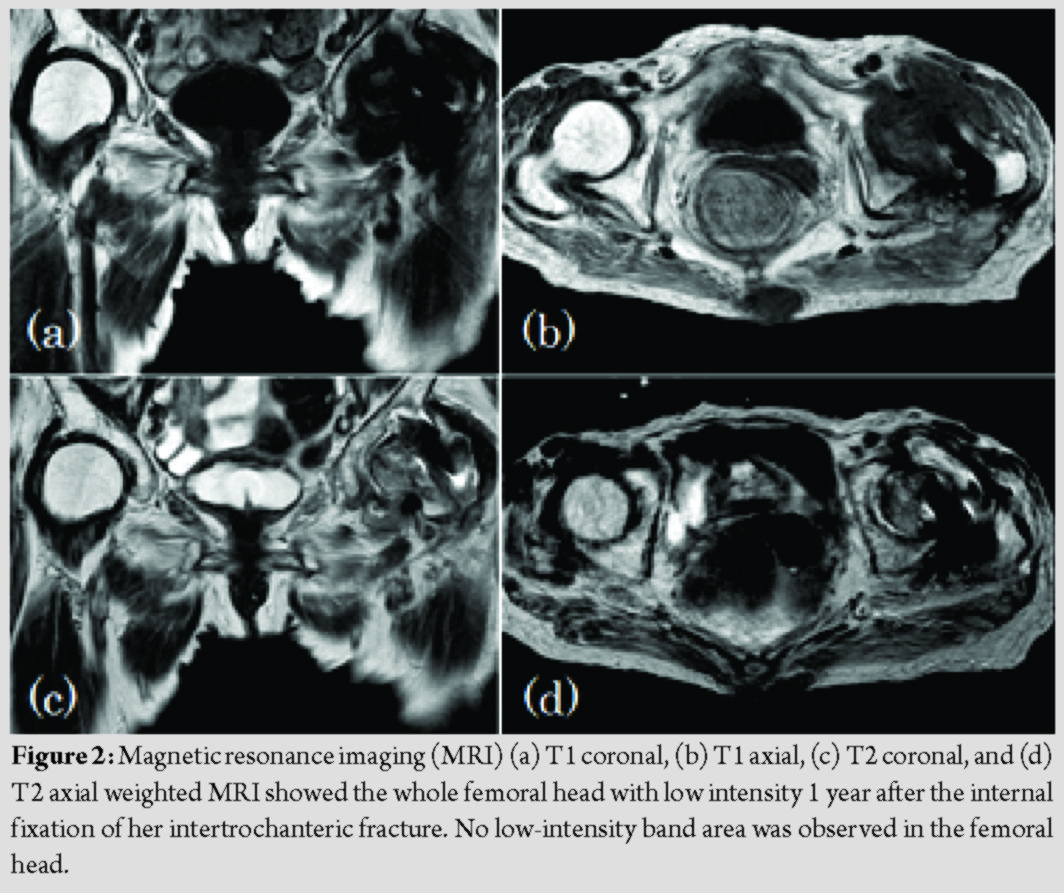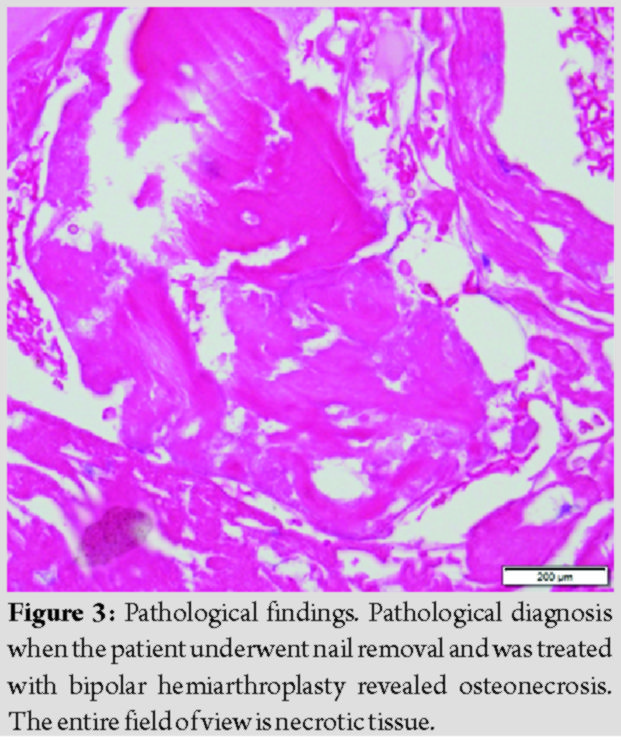[box type=”bio”] Learning Point of the Article: [/box]
We should consider the possibility of avascular necrosis of the whole femoral head following intertrochanteric fracture fixation as a cause of this subcapital fracture.
Case Report | Volume 10 | Issue 4 | JOCR July 2020 | Page 42-44 | Natsuko Fukuoka, Keisuke Oe, Atsushi Sakurai, Takahiro Niikura, Ryosuke Kuroda, Tetsuji Yamamoto. DOI: 10.13107/jocr.2020.v10.i04.1794
Authors: Natsuko Fukuoka[1], Keisuke Oe[2], Atsushi Sakurai[3], Takahiro Niikura[2], Ryosuke Kuroda[2], Tetsuji Yamamoto[1]
[1]Department of Orthopaedic Surgery, Kagawa University Faculty of Medicine, 1750-1 Ikenobe, Miki-cho, Kita-gun, Kagawa 761-0793, Japan,
[2]Department of Orthopaedic Surgery, Kobe University Graduate School of Medicine, 7-5-1 Kusunoki-cho, Chuo-ku, Kobe, 650-0017, Japan,
[3]Department of Orthopaedic Surgery, Hyogo Prefectural Awaji Medical Center, 1-1-137 Shioya, Sumoto City, Hyogo, 656-0021, Japan.
Address of Correspondence:
Dr. Keisuke Oe,
Department of Orthopaedic Surgery, Kobe University Graduate School of Medicine, 7-5-1 Kusunoki-cho, Chuo-ku, Kobe, 650-0017, Japan.
E-mail: keisukeo@med.kobe-u.ac.jp
Abstract
Introduction: Subcapital fractures following internal fixation of an intertrochanteric fracture are relatively rare. It has been reported that these fractures are caused by improper placement of implants, osteoporosis, and any trauma episode. We report a rare case of subcapsular fracture possibly caused by whole femoral head necrosis following intertrochanteric fracture treatment.
Case Report: An 88-year-old woman fell and sustained an intertrochanteric fracture of the left femur. She was treated with a short femoral nail (SFN) and 3 months after the surgery, bone union was observed. One year after the internal fixation of the intertrochanteric fracture, she complained of the left hip joint pain without any trauma, and the X-ray showed a subcapital fracture of the femur. She underwent nail removal and was treated with a bipolar hemiarthroplasty. Magnetic resonance imaging showed a change in the signal intensity of the entire head, and pathological findings revealed osteonecrosis. Normally, the reaction of bone resorption occurs below the necrosis area. We believe that the avascular necrosis (AVN) of the whole femoral head made the subcapital area fragile, resulting in a subcapital fracture.
Conclusions: We should consider AVN of the whole femoral head as a potential cause of subcapital fracture after SFN fixation of intertrochanteric fractures.
Keywords: Subcapital fracture, intertrochanteric fracture, whole femoral head necrosis.
Introduction
Subcapital fractures after the internal fixation of intertrochanteric fractures are rare, with only a few cases previously reported in the literature. The incidence of this fracture is 0.2–3.3% [1]. It has been reported that these fractures are caused by the improper placement of implants, osteoporosis, or episodes of trauma [1, 2, 3]. In addition, avascular necrosis (AVN) of the femoral head following an intertrochanteric fracture is also a rare occurrence, with an incidence range of 0.3–0.58% [4]. The possible etiologies of this complication include a more proximal intertrochanteric fracture, a high-energy injury with fracture displacement resulting in vascular damage, and adverse influences on the vascularity of the femoral head during the operative procedure [6]. We report a case of subcapital fracture with AVN of the whole femoral head after healed fixation of an intertrochanteric fracture.
Case Report
An 88-year-old woman with a history of hypertension, angina, and bronchial asthma, and who had never used steroids, fell, and sustained an intertrochanteric fracture of her left femur (AO/OTA classification: 31A1.2) (Fig. 1a and e).  She was treated with a short femoral nail (SFN) the day after the injury (Fig. 1b and f). The operative fixation was considered satisfactory; she was, therefore, allowed full weight-bearing walking on the 2nd day after the operation. Bony union was achieved in 3 months, and there was no problem with the placement of the implant. She progressed to the use of a walker for ambulation with full weight-bearing (Fig. 1c and g). One year after osteosynthesis, the patient complained of the left hip pain without any associated trauma.
She was treated with a short femoral nail (SFN) the day after the injury (Fig. 1b and f). The operative fixation was considered satisfactory; she was, therefore, allowed full weight-bearing walking on the 2nd day after the operation. Bony union was achieved in 3 months, and there was no problem with the placement of the implant. She progressed to the use of a walker for ambulation with full weight-bearing (Fig. 1c and g). One year after osteosynthesis, the patient complained of the left hip pain without any associated trauma.  The X-ray showed a displaced subcapital fracture, and T1- and T2-weighted magnetic resonance imaging (MRI) revealed low intensity (no crescent sign) of the whole femoral head (Fig. 1d and h and 2). She underwent SFN removal and was treated with bipolar hemiarthroplasty (BHA). The surgeon selected BHA in consideration of surgical invasion, age, and activity of the patient. Fortunately, the X-rays at the time of the final survey (1 year after the BHA) did not show any destruction of the acetabulum. A pathological examination of the femoral head indicated necrosis of the femoral head (Fig. 3).
The X-ray showed a displaced subcapital fracture, and T1- and T2-weighted magnetic resonance imaging (MRI) revealed low intensity (no crescent sign) of the whole femoral head (Fig. 1d and h and 2). She underwent SFN removal and was treated with bipolar hemiarthroplasty (BHA). The surgeon selected BHA in consideration of surgical invasion, age, and activity of the patient. Fortunately, the X-rays at the time of the final survey (1 year after the BHA) did not show any destruction of the acetabulum. A pathological examination of the femoral head indicated necrosis of the femoral head (Fig. 3).
Discussion
Subcapital fractures are relatively rare after trochanteric fractures. Tronzo was the first to describe a subcapital fracture following fixation of an intertrochanteric fracture. He described the importance of the distance between tip of lag screw and the subchondral bone of the femoral head; he suggested that when the tip of the fixation device was located around the epiphyseal scar, it could cause a subcapital stress fracture [6]. The distance between the articular surface and the dynamic hip screw tip is the risk factor; the tip should be placed within 10 mm of the articular surface. The other risk factors for subcapital fractures are patient’s age, female gender, presence of osteoporosis, type of fixation device, and/or small femoral head and neck [1, 7]. In our case, there was no subsequent trauma before the subcapital fracture, good reduction was obtained, and there were no errors in the surgical technique to account for such a fracture. Considering the age and sex of patients with intertrochanteric fractures, osteopenia was a common denominator not only in the subsequent subcapital fracture but also in the initial intertrochanteric fracture. Therefore, we considered that AVN of the whole femoral head following the initial intertrochanteric fracture led to the subsequent subcapital fracture; however, this has not been documented in any previous case reports [8]. It is considered that the mechanism resulting in the subcapital fracture involves the bone repair occurring just below the necrotic area so that the site becomes fragile and the fractures occur [9, 10]. Normally, idiopathic necrosis of the femoral head results in a subchondral fracture with the crescent sign observed in the X-ray image, instead of a subcapital fracture, and collapse of the femoral head should be observed. MRI also shows a signaling change only in the subchondral area [11]. In our case, MRI findings showed a signaling change in the entire head and pathological findings showed osteonecrosis (Fig. 2 and 3). Since the MRI examination was performed after the subcapital fracture, there is a possibility that the edematous change may have occurred after the fracture. However, based on the pathological results, we considered whole femoral head necrosis. Although the cause of whole femoral head necrosis is unclear, there are cases in which subcapital fractures may occur due to whole femoral head necrosis after intertrochanteric fractures.
Conclusions
Subcapital fractures after intertrochanteric fracture fixation with the SFN are rare. Although some causes are mentioned, they do not correspond to the events of this case. We should consider the possibility of AVN of the whole femoral head following intertrochanteric fracture fixation as a cause of this subcapital fracture. Good reduction and surgical technique are important in preventing these fractures. Furthermore, careful post-operative follow-up is necessary to monitor these patients for signs of AVN after surgery.
Clinical Message
There are rare reports of subcapital fractures following intertrochanteric fracture fixation related to subsequent trauma or the position of the fixation device. This is the first report in English of AVN of the whole femoral head, which developed after intertrochanteric fracture fixation with a SFN and caused a subcapital fracture.
References
1. Barquet A, Giannoudis PV, Gelink A. Femoral neck fractures after internal fixation of fractures with implants in situ in adults: A systematic review. Injury 2018;49:2121-31.
2. Vicario C, Marco F, Ortega L, Alcobendas M, Dominguez I, López-Durán L. Necrosis of the femoral head after fixation of trochanteric fractures with Gamma Locking Nail. A cause of late mechanical failure. Injury 2003;34:129-34.
3. Mariani EM, Rand JA. Subcapital fractures after open reduction and internal fixation of intertrochanteric fractures of the hip. Report of three cases. Clin Orthop Relat Res 1989;245:165-8.
4. Barquet A, Mayora G, Guimaraes JM, Suarez R, Giannoudis PV. Avascular necrosis of the femoral head following trochanteric fractures in adults: A systematic review. Injury 2014;45:1848-58.
5. Shih LY, Chen TH, Lo WH. Avascular necrosis of the femoral head an unusual complication of an intertrochanteric fracture. J Orthop Trauma 1992;6:382-5.
6. Tronzo RG. Surgery of the Hip Joint. Philadelphia, PA: Lea and Febiger; 1973. p. 525-27.
7. Lung YT, Kam WL, Leung YF, Chung OM, Wai YL. Subcapital femoral neck fracture following successful trochanteric fracture treatment with a dynamic hip screw: A report of five cases. J Orthop Surg (Hong Kong) 2007;15:238-41.
8. Gogan WJ, Daum WJ, Simmons DJ, Evans EB. Subcapital fracture of the hip following an intertrochanteric fracture. A case report and literature review. Clin Orthop Relat Res 1988;232:205-9.
9. Min BW, Koo KH, Song HR, Cho SH, Kim SY, Kim YM, et al. Subcapital fractures associated with extensive osteonecrosis of the femoral head. Clin Orthop Relat Res 2001;390:227-31.
10. Sueki H, Yamamoto M. Subcapital fracture after treatment of trochanteric fracture. Kanto J Orthop Traumatol 2011;42:240-3.
11. Saini A, Saifuddin A. MRI of osteonecrosis. Clin Radiol 2004;59:1079-93.
 |
 |
 |
 |
 |
| Dr. Natsuko Fukuoka | Dr. Keisuke Oe | Dr. Atsushi Sakurai | Dr. Ryosuke Kuroda | Dr. Tetsuji Yamamoto |
| How to Cite This Article: Fukuoka N, Oe K, Sakurai A, Niikura T, Kuroda R, Yamamoto T. Subcapital fracture with avascular necrosis of the whole femoral head after fixation of an intertrochanteric fracture: A case report. Journal of Orthopaedic Case Reports 2020 July;10(4): 42-44. |
[Full Text HTML] [Full Text PDF] [XML]
[rate_this_page]
Dear Reader, We are very excited about New Features in JOCR. Please do let us know what you think by Clicking on the Sliding “Feedback Form” button on the <<< left of the page or sending a mail to us at editor.jocr@gmail.com




